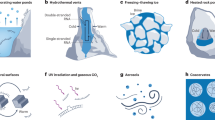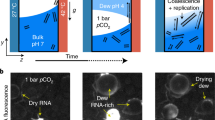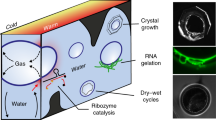Abstract
The replication of nucleic acids is central to the origin of life. On the early Earth, suitable non-equilibrium boundary conditions would have been required to surmount the effects of thermodynamic equilibrium such as the dilution and degradation of oligonucleotides. One particularly intractable experimental finding is that short genetic polymers replicate faster and outcompete longer ones, which leads to ever shorter sequences and the loss of genetic information. Here we show that a heat flux across an open pore in submerged rock concentrates replicating oligonucleotides from a constant feeding flow and selects for longer strands. Our experiments utilize the interplay of molecular thermophoresis and laminar convection, the latter driving strand separation and exponential replication. Strands of 75 nucleotides survive whereas strands half as long die out, which inverts the above dilemma of the survival of the shortest. The combined feeding, thermal cycling and positive length selection opens the door for a stable molecular evolution in the long-term microhabitat of heated porous rock.
This is a preview of subscription content, access via your institution
Access options
Subscribe to this journal
Receive 12 print issues and online access
$259.00 per year
only $21.58 per issue
Buy this article
- Purchase on Springer Link
- Instant access to full article PDF
Prices may be subject to local taxes which are calculated during checkout




Similar content being viewed by others
References
Powner, M. W., Gerland, B. & Sutherland, J. D. Synthesis of activated pyrimidine ribonucleotides in prebiotically plausible conditions. Nature 459, 239–242 (2009).
Sievers, D. & Von Kiedrowski, G. Self-replication of complementary nucleotide-based oligomers. Nature 369, 221–224 (1994).
Mansy, S. S. et al. Template-directed synthesis of a genetic polymer in a model protocell. Nature 454, 122–125 (2008).
Wochner, A., Attwater, J., Coulson, A. & Holliger, P. Ribozyme-catalyzed transcription of an active ribozyme. Science 332, 209–212 (2011).
Paul, N. & Joyce, G. F. A self-replicating ligase ribozyme. Proc. Natl Acad. Sci. USA 99, 12733–12740 (2002).
Yang, Z., Chen, F., Alvarado, J. B. & Benner, S. A. Amplification, mutation, and sequencing of a six-letter synthetic genetic system. J. Am. Chem. Soc. 133, 15105–15112 (2011).
Szostak, J. W. The eightfold path to non-enzymatic RNA replication. J. Syst. Chem. 3, 1–14 (2012).
Pascal, R., Pross, A. & Sutherland, J. D. Towards an evolutionary theory of the origin of life based on kinetics and thermodynamics. Open Biol. 3, 130156 (2013).
Powner, M. W., Sutherland, J. D. & Szostak, J. W. Chemoselective multicomponent one-pot assembly of purine precursors in water. J. Am. Chem. Soc. 132, 16677–16688 (2010).
Schrödinger, E. What is Life? (Cambridge Univ. Press, 1944).
Mills, D. R., Peterson, R. L. & Spiegelman, S. An extracellular Darwinian experiment with a self-duplicating nucleic acid molecule. Proc. Natl Acad. Sci. USA 58, 217–224 (1967).
Lay, T., Hernlund, J. & Buffett, B. A. Core–mantle boundary heat flow. Nature Geosci. 1, 25–32 (2008).
Baaske, P. et al. Extreme accumulation of nucleotides in simulated hydrothermal pore systems. Proc. Natl Acad. Sci. USA 104, 9346–9351 (2007).
Budin, I., Bruckner, R. J. & Szostak, J. W. Formation of protocell-like vesicles in a thermal diffusion column. J. Am. Chem. Soc. 131, 9628–9629 (2009).
Mast, C. B., Schink, S., Gerland, U. & Braun, D. Escalation of polymerization in a thermal gradient. Proc. Natl Acad. Sci. USA 110, 8030–8035 (2013).
Clusius, K. & Dickel, G. Trennung von Flüssigkeitsgemischen mittels kombinierter Thermodiffusion und Thermosiphonwirkung. Naturwissenschaften 26, 546 (1938).
Debye, P. Zur Theorie des Clusiusschen Trennungsverfahrens. Annal. Phys. 428, 284–294 (1939).
Piazza, R. & Guarino, A. Soret effect in interacting micellar solutions. Phys. Rev. Lett. 88, 208302 (2002).
Duhr, S. & Braun, D. Why molecules move along a temperature gradient. Proc. Natl Acad. Sci. USA 103, 19678–19682 (2006).
Krishnan, M., Ugaz, V. M. & Burns, M. A. PCR in a Rayleigh–Benard convection cell. Science 298, 793 (2002).
Mast, C. B. & Braun, D. Thermal trap for DNA replication. Phys. Rev. Lett. 104, 188102 (2010).
Rajamani, S. et al. Effect of stalling after mismatches on the error catastrophe in nonenzymatic nucleic acid replication. J. Am. Chem. Soc. 132, 5880–5885 (2010).
Tritt, T. M. Thermal Conductivity: Theory, Properties and Applications (Kluwer Academic/Plenum, 2004).
Braun, D., Goddard, N. L. & Libchaber, A. Exponential DNA replication by laminar convection. Phys. Rev. Lett. 91, 158103 (2003).
Fernando, C., Von Kiedrowski, G. & Szathmáry, E. A stochastic model of nonenzymatic nucleic acid replication: “Elongators” sequester replicators. J. Mol. Evol. 64, 572–585 (2007).
Baaske, P., Wienken, C. J., Reineck, P., Duhr, S. & Braun, D. Optical thermophoresis for quantifying the buffer dependence of aptamer binding. Angew. Chem. Int. Ed. 49, 2238–2241 (2010).
Wilhelm, J. & Pingoud, A. Real-time polymerase chain reaction. ChemBioChem 4, 1120–1128 (2003).
Kelley, D. S. et al. An off-axis hydrothermal vent field near the Mid-Atlantic Ridge at 30° N. Nature 412, 145–149 (2001).
Acknowledgements
We thank N. Osterman and C. Mast for the preliminary trapping experiments and discussions, M. Herzog and M. Reichl for thermophoresis measurements and S. Krampf for help with the gel electrophoresis. Financial support from the NanoSystems Initiative Munich, the Simons Collaboration on the Origin of Life, the Ludwig-Maximilians-Universität Munich Initiative Functional Nanosystems, the SFB 1032 Project A4 and the European Research Council (ERC) Starting Grant is acknowledged.
Author information
Authors and Affiliations
Contributions
M.K., L.K. and S.L. contributed equally to this work and performed the experiments. M.K., L.K., S.L and D.B. conceived and designed the experiments, analysed the data and wrote the paper.
Corresponding author
Ethics declarations
Competing interests
The authors declare no competing financial interests.
Supplementary information
Supplementary information
Supplementary information (PDF 2489 kb)
Supplementary information
Supplementary Movie 1 (MP4 5456 kb)
Supplementary information
Supplementary Movie 2 (MP4 1169 kb)
Supplementary information
Supplementary Movie 3 (MP4 3245 kb)
Supplementary information
Supplementary Movie 4 (MP4 901 kb)
Rights and permissions
About this article
Cite this article
Kreysing, M., Keil, L., Lanzmich, S. et al. Heat flux across an open pore enables the continuous replication and selection of oligonucleotides towards increasing length. Nature Chem 7, 203–208 (2015). https://doi.org/10.1038/nchem.2155
Received:
Accepted:
Published:
Issue Date:
DOI: https://doi.org/10.1038/nchem.2155
This article is cited by
-
Multicompartmental coacervate-based protocell by spontaneous droplet evaporation
Nature Communications (2024)
-
Physical non-equilibria for prebiotic nucleic acid chemistry
Nature Reviews Physics (2023)
-
Formation mechanism of thermally controlled pH gradients
Communications Physics (2023)
-
Emergence of energy-avoiding and energy-seeking behaviors in nonequilibrium dissipative quantum systems
Communications Physics (2022)
-
Mist and replication
Nature Physics (2022)



